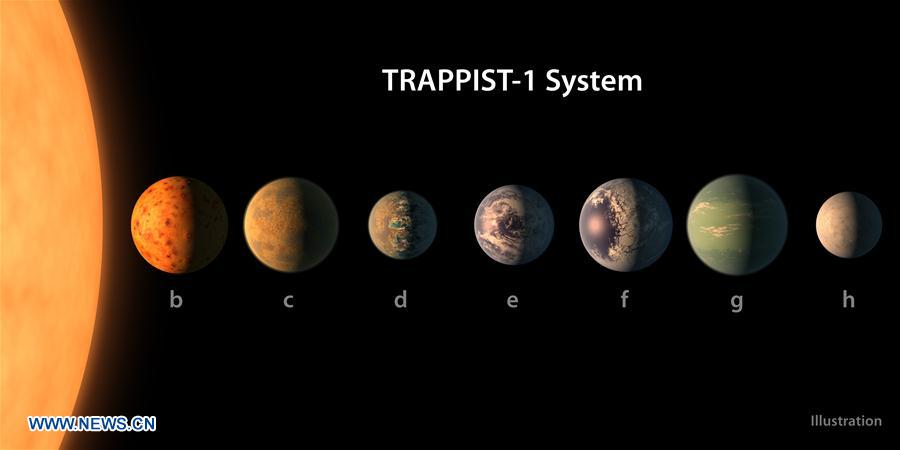Related reading:
LOS ANGELES, Feb. 22 (Xinhua) -- A compact analogue of our inner solar system about 40 light years away has been discovered, the U.S. space station NASA announced at a press conference on Wednesday.

The illustration released by NASA on Feb. 22, 2017 shows the artist's concept of what the TRAPPIST-1 planetary system may look like, based on available data about the planets' diameters, masses and distances from the host star. A compact analogue of our inner solar system about 40 light years away from the Earth has been discovered, NASA announced during a press conference on Wednesday. An international team of astronomers using powerful space telescopes and ground-based observatories have discovered the first known system of actually seven Earth-sized planets orbiting the nearby TRAPPIST-1, which is relatively close to us, in the constellation Aquarius. And three of these planets are firmly located in the habitable zone, the area around the parent star where a rocky planet is most likely to have liquid water. (Xinhua/NASA/JPL-Caltech)
"The discovery gives us a hint that finding a second earth is not just a matter of if but when," Thomas Zurbuchen, Associate Administrator of the Science Mission Directorate said.
By using powerful space telescopes and ground-based observatories, an international team of astronomers have discovered the first known system of actually seven Earth-size planets orbiting the nearby TRAPPIST-1, which is relatively close to us, in the constellation Aquarius.
"Around a nearby, cold, small star we found 7 rocky Earth-size planets, all of which could have liquid water -- key to life as we know it," NASA posted on Twitter.
Three of these planets are firmly located in the habitable zone, the area around the parent star where a rocky planet is most likely to have liquid water.
The discovery sets a new record for greatest number of habitable-zone planets found around a single star outside our solar system, according to the NASA.
"With the discovery, we have made a giant accelerated leap forward in the search for habitable worlds and life on other worlds," Sara Seager, professor of Planetary Science and Physics, MIT, said. "Potentially because with not just one planet, but several," she added.
The new results were published Wednesday in the journal Nature, and announced at a news briefing at the NASA Headquarters in Washington.
"The seven wonders of TRAPPIST-1 are the first Earth-size planets that have been found orbiting this kind of star," said Michael Gillon, lead author of the paper and the principal investigator of the TRAPPIST exoplanet survey at the University of Liege, Belgium.
TRAPPIST-1, classified as an small, ultra-cool dwarf, is the new hot topic in astronomy and the search for life outside our solar system. In contrast to our sun, the dwarf is so cool that liquid water could survive on planets orbiting very close to it, closer than is possible on planets in our solar system.
In May 2016, astronomers announced the discovery of three planets in the system, but even then they suspected there might be a few more.
Assisted by several ground-based telescopes, including the European Southern Observatory's Very Large Telescope, NASA's Spitzer Space Telescope confirmed the existence of two of these planets and discovered five additional ones, increasing the number of known planets in the system to seven.
Using Spitzer data, the research team precisely measured the sizes of the seven planets and developed first estimates of the masses of six of them, allowing their density to be estimated. Based on their densities, all of the planets in the system are likely to be rocky.
"Looking for life elsewhere, this system is probably our best bet as of today," Brice-Olivier Demory, professor at the University of Bern's Center for Space and Habitability and one of the authors of the Nature paper, said in a statement.
Earth-like exoplanets orbiting dwarf stars are easier to observe than real Earth twins around solar-type stars, according to the new study.















